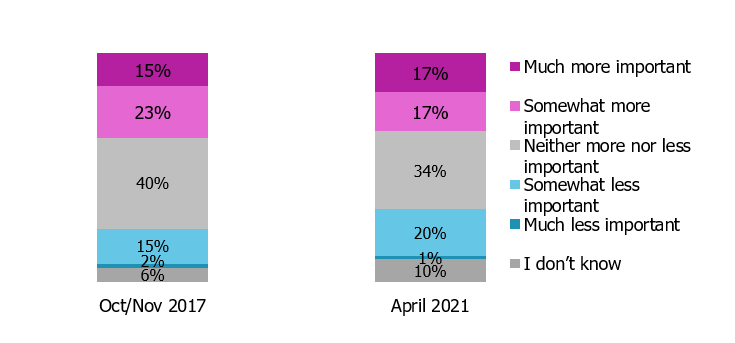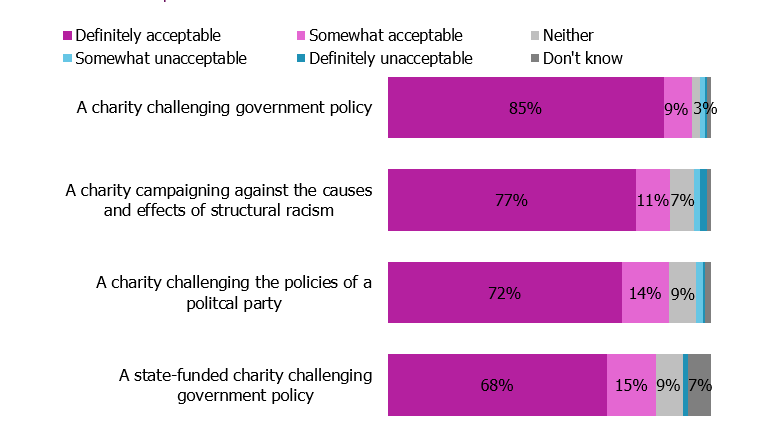Max Roche
The last five years have presented a number of challenges for charity media teams. An existential political crisis that came with the 2015 European referendum, followed by a global pandemic has meant news cycles have been dominated by major national issues.
Bringing in the new year with nearly 200,000 cases[1] left little room for optimism that 2022 might change that. But already the fears of starting another year in lockdown feel distant. Providing media and political circles can move on from ‘Party gate’, there should be some optimism that 2022 will finally be the year where we are less saturated by Brexit and Covid.
For charities, this can only be good news. With more public, political, and media bandwidth there is a real opportunity for charities to speak up about issues that would have previously struggled to garner attention. With this in mind the important question for charities is what is the best means of getting their message out?
How should charities be getting their message out?
In 2021 we conducted research with 152 journalists from across the charity sector. We asked them whether they thought they would play a more or less important role in helping charities get their message out in five years’ time. This question was one that we also asked back in 2017 and we found similar results both times around.
Chart One: The importance of journalists for the charity sector in five years’ time

Do you think that journalists will play a more important or less important role in charities getting their message out in five years’ time?” Prompted question
Base: 152 journalists | Source: Journalists' Attitudes and Awareness Monitor, April 2021, nfpSynergy
As Chart One shows, only 1 in 3 journalists (34%) think they will play a more important role in five years’ time which is very similar to the 38% from 2017. Around 1 in 5 (21%) think they will play a less important role, whilst one in three journalists (34%) think they will become neither more nor less important in helping charities get their message out.
To address the pessimism first, the main fear journalists expressed surrounded the rise of social media. Social media platforms are cheap, accessible (in most countries), and have fundamentally revolutionised how we produce and consume information. Charities now have the means to communicate directly with swathes of volunteers, beneficiaries, donors, and interested parties in a way that they simply couldn’t a decade ago.
A number of journalists we surveyed were only too aware of this trend. As the following comments suggest, there is a real concern they could be eclipsed by this more direct form of communication:
“Journalism as we know it is dying and charities are increasingly getting their message across through social media.” (The Guardian, Sky News)
“Social media is allowing charities to more directly reach the public.” (Birmingham TV)
Not all journalists felt this way however and many recognised that they can still offer something different to charities.
Firstly, they mentioned the wider scope they can provide for charity stories. Social media offers an important opportunity to engage with large sections of the population but is ultimately somewhat limited in exposure to those that are already warm to an organisation. Of course, users can share content but questions are often raised as to whether these are simply recycled around echo chambers of likeminded individuals.
Journalists can reach audiences beyond a charity follower base. A number of journalists mentioned this in their responses:
“There is a temptation to think that charities can get their message out directly through greater use of social media, etc. But with the advent of fake news and issues of ever-narrowing audiences following from targeted online content, I think there will be a resurgence of support for trusted news sources with a proven track record, so journalists can help charities reach beyond established audiences or supporter base.” (The Times)
“Although social media can be used to push campaigns, media attention still makes a significant difference in bringing 'viral' campaigns to wider attention.” (Freelance)
These sentiments are borne out in the data. The most followed charities on Twitter, as of October 2021, were the National Trust (929k followers), Macmillan Cancer Support (666k followers) and Mind (508k followers).[2]
By contrast, a 2019 Ofcom report on news consumption patterns in the UK, found that the three most widely read print and online newspapers were the Daily Mail (9,623k readers), The Guardian (8,031k readers), and the Metro (6,786k readers).[3] There can be no doubt therefore that coverage in a national newspaper provides far greater exposure than through social media platforms.
A second point to consider is the type of exposure generated. Whilst media teams are highly skilled at using online platforms to promote their content, journalists do offer an altogether different form of exposure. As the following comments suggest:
“Charities are good at getting their message out but that is rarely the same as compelling human stories that really grip people - journalists and other outsider storytellers tend to do that.” (Freelance)
“I think social media is really important for charities to connect personally with people. But I think there will always be a place for media to share stories in a way that resonates with people and makes them think.” (Press Association)
Of course, this question does not need a binary answer as to which medium is more effective, and ultimately utilising both is key to any media strategy. Having direct access to social media platforms has certainly brought important changes to the way charities are able to communicate but to suggest this could altogether eclipse the scale and type of exposure offered by journalism is a step too far.
What sort of messages are journalists interested in?
In our 2021 research, we also asked journalists about the acceptability of certain charity actions. We found that almost all journalists thought it acceptable for charities to challenge government policy and a further 83% said they thought it acceptable for a state funded charity to challenge government policy.
These findings are very welcome given growing concerns that the media climate has become more hostile to charity campaigning. A report from the Shelia McKechnie Foundation in 2020 found that from a poll of UK campaigners and activists, 49% thought the media climate had become more negative towards campaigning, up from 41% the previous year.[4]
Chart Two: Acceptable actions for charities

Please rate how acceptable or unacceptable you find each of the below actions.” Prompted question, ranked by Definitely acceptable and somewhat acceptable combined
Base: 152 journalists | Source: Journalists' Attitudes and Awareness Monitor, April 2021, nfpSynergy
Our findings suggest that journalists who are warm to the sector are actually very happy for charities to play a more combative role in society and openly challenge the government. This data cannot say for sure whether journalists will cover a specific charity campaign - although for those who are interested, we do ask about specific campaigns on behalf of charities who take part in our research. What it does suggest is that the media will not be hostile towards charities putting out these sorts of messages.
This is especially important considering the current socio-economic climate. With rising inflation, tax hikes, and soaring energy prices all contributing to a cost-of-living crisis that threatens to push thousands of families into poverty, it’s welcome news that the media is ready to hear charities challenging the government. As these crises unfold, these voices will be more vital than ever.
[1] BBC, Covid: UK cases reach record again as PM urges New Year's Eve caution, https://www.bbc.co.uk/news/uk-59834667
[2] nfpSynergy internal report on Charity Social Media consumption – October 2021
[3] Ofcom, News Consumption in the UK: 2019 report, https://www.ofcom.org.uk/__data/assets/pdf_file/0027/157914/uk-news-con…
[4] Third Sector, Charity campaigners facing an increasingly hostile political environment, research suggests, https://www.thirdsector.co.uk/charity-campaigners-facing-increasingly-h…

